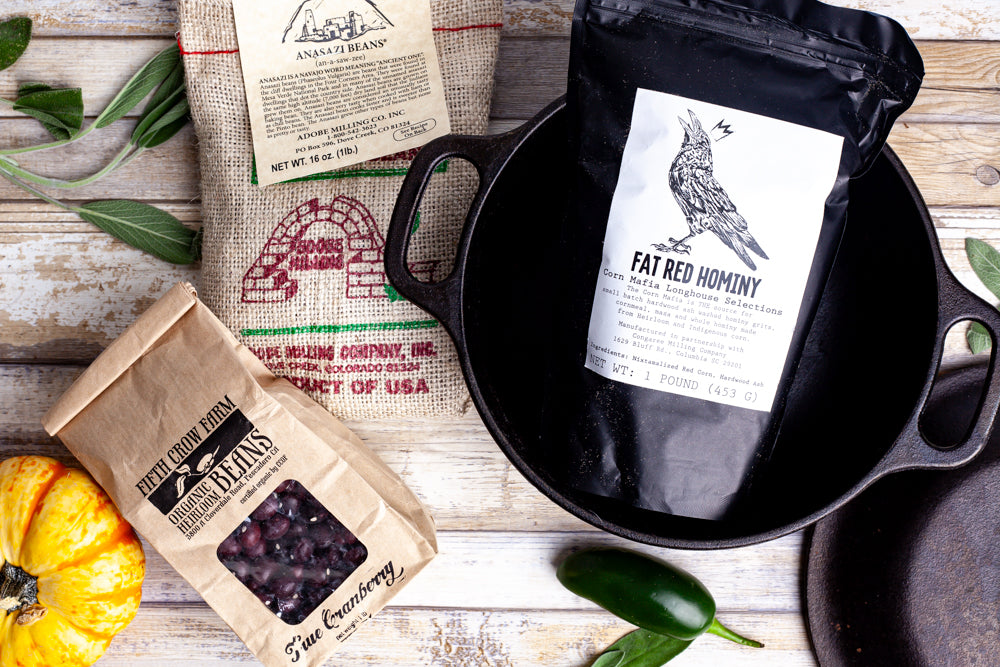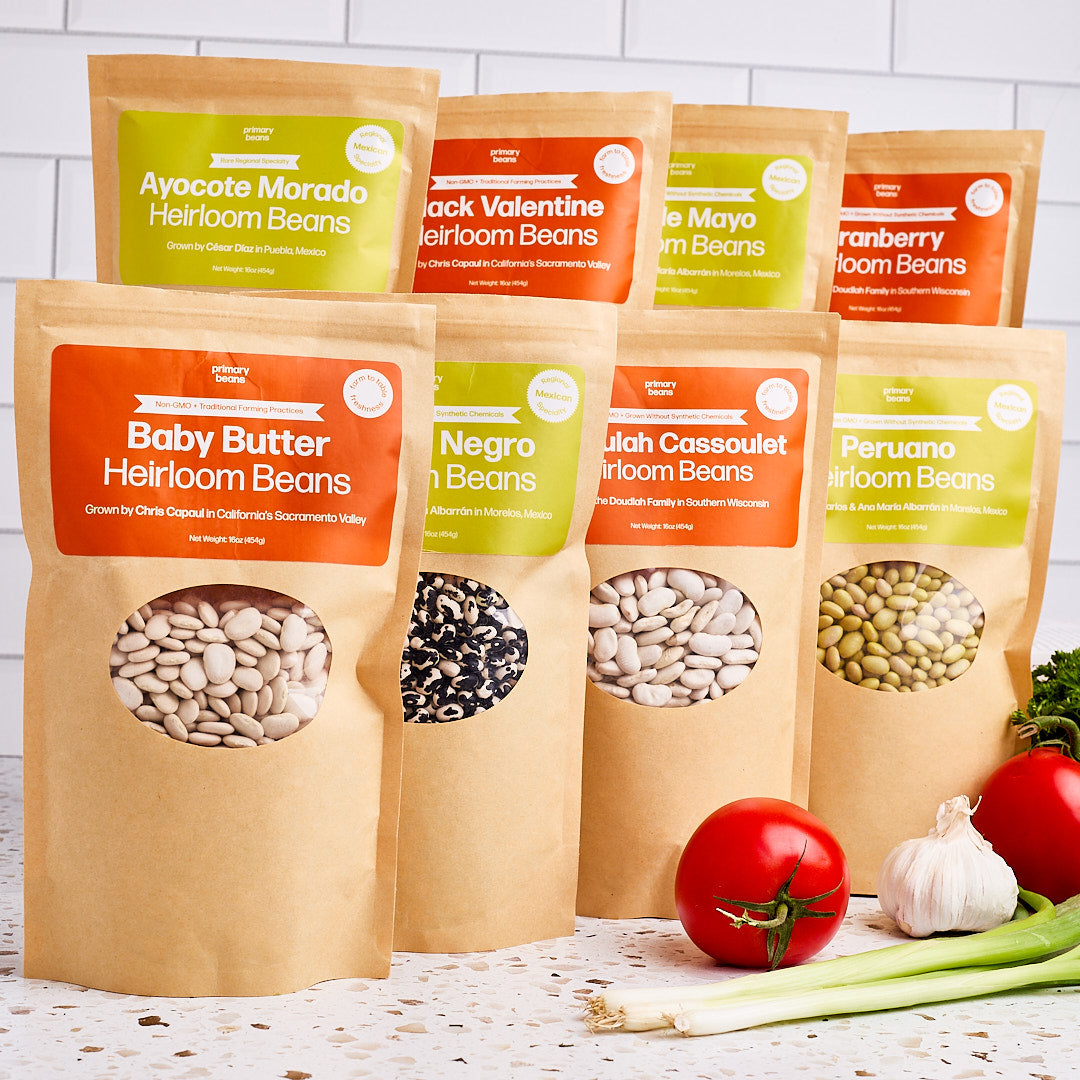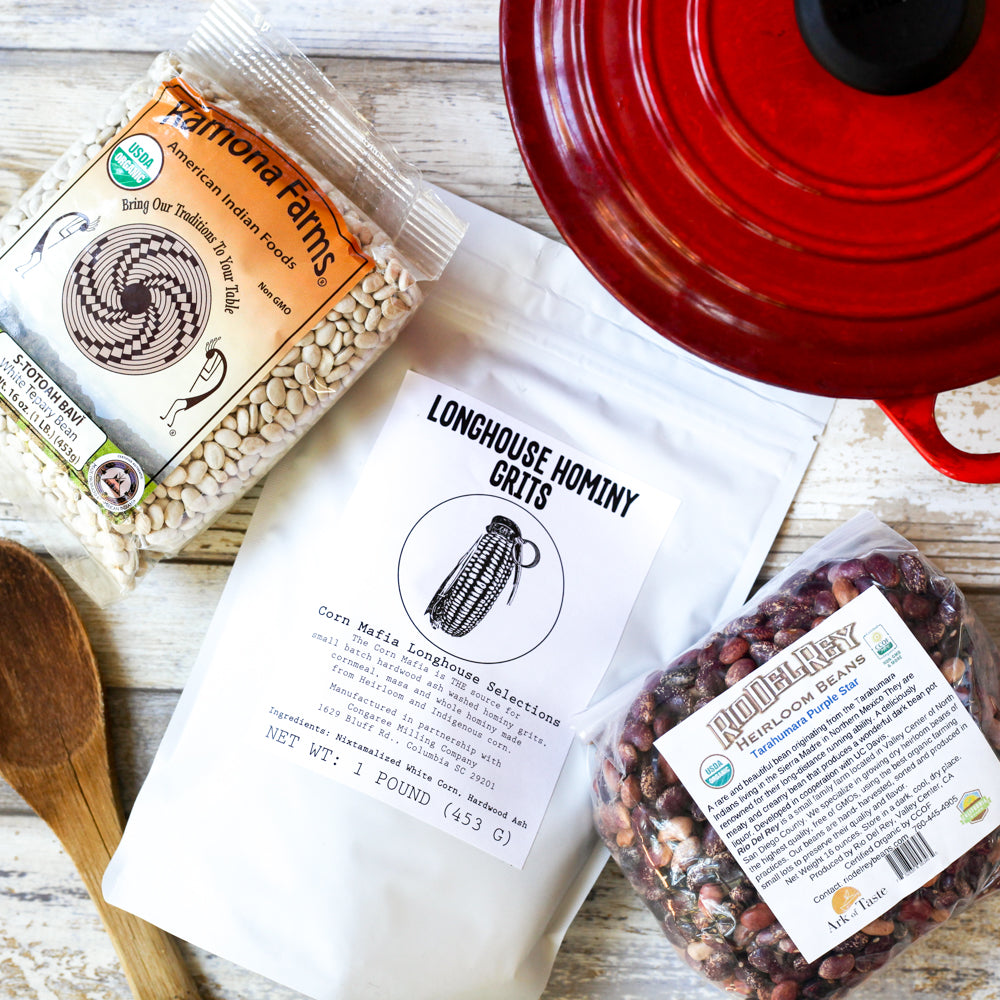10.99 FLAT RATE SHIPPING
10.99 FLAT RATE SHIPPING
SHOP

November 2023 Heirloom Bean + Grain Club
November 02, 2023 6 min read
As we step into the heart of November, we're privileged to celebrate Indigenous Heritage Month with a collection that pays homage to the diverse cultures and traditions rooted in Turtle Island. Our curated box is a humble invitation to explore and appreciate the rich tapestry of indigenous ingredients, each carefully selected to honor and respect the culinary legacies of these communities. Behold the True Red Cranberry beans, whose vibrant hues reflect a history deeply connected to the land. Embraced in a burlap sack, the Anasazi beans carry stories of resilience and tradition. Adding a touch of culinary artistry, we present the sought-after Fat Red Hominy from the esteemed kitchen of chef Dave "Smoke" McClusky. In the spirit of fostering understanding, we encourage you to delve into the heritage of Turtle Island, learning more about the cultures that have cultivated these treasures for generations. Join us in savoring November not just as a season, but as an opportunity to appreciate the flavors that echo the wisdom and stories of our shared heritage.
THE BEAN AND GRAIN BOX CONTAINS:
Organic True Red Cranberry Beans, Anasazi Beans, Fat Red Hominy
THE BEAN ONLY CONTAINS:
Organic True Red Cranberry Beans, Anasazi Beans, Calypso Beans
NEW TO THE CLUB?
Check out our blogposts with everything you need to know to get the most out of your membership in the heirloom bean and grain club.
How To Cook A Perfect Pot of Beans
The Definitive Guide To Cooking Beans
TRUE RED CRANBERRY
This stunning blood red bean is recognized in the Slow Food Ark of Taste and indeed resembles its namesake. One of America's oldest and most unique varieties, The Red Cranberry bean was rediscovered by bean collector John Withee after an 11-year quest in Steep Falls Maine. This rare heirloom had been used by Abnaki Indians centuries ago but became extinct shortly thereafter due its tall stature that made it difficult for harvesting when grown at lowlands or gradual slopes. This plumps up to be marble sized jewels with a dense yet creamy texture and a rich, earthy flavor.
WHAT TO DO WITH IT
We think there could be no better bean to use in Sean Sherman's Cedar Braised Beans than the True Red Cranberry. No cedar branches at your local market? No problem try a sprinkle of the cedar smoked salt from Sekari Farms and a drizzle of olive oil from Seka Hills support two tribal owned businesses! These flavorful little gems are also amazing in our 3 Sisters Tamales!

ABOUT THE FARMER
Fifth Crow Farms is an organic family owned farm in Pescadero, California. Grounded in a values-based approach to land stewardship, Fifth Crow Farm is a dynamic and diversified organic farm in Pescadero, CA. Founded in 2008 with a shoestring budget, a supportive local community, and ambitious dreams, they strive to bring eaters the highest quality, best tasting, and most nutritious food possible.
Fifth Crow Farm wants their farm to be more than a business: they strive to make it an engine for positive change in the food system. They are stewarding the land in a way that not only respects but improves habitat for wildlife and builds better soil for future farmers. They also believe in creating a healthy, fulfilling, and fair work environment, and providing their customers with the best tasting, most nutritious, highest quality food possible.
ANASAZI BEANS
You'll find many a cook that waxes poetic about the many virtues of this beautiful little maroon and white mottled bean. It is thought to be an ancient ancestor of pinto beans because of the color but that's where the comparison stops. It is revered for not only it's sweet, dense flavor but also its quicker cooking times and the fact that there is no need to soak them.
Anasazi Beans have been grown by the Anasazi people in what is now called the four corners region of the United States dating back to at least 130 AD. They are sometimes called New Mexico Cave Beans because they were found in the ruins of their famous cave dwellings in New Mexico and Colorado.
These beans come to us from the Adobe Milling Company in Dove Colorado which holds a registered trademark on Anasazi name.
WHAT TO DO WITH THEM
These are exceptionally delicious and beloved by chefs. The fast cook time means they're probably the bag that will disappear the fastest out of your box. As with all beans we recommend at least cooking some with only salt and seasoning later. Cooking time on these is just 1 to 2 hours on the stovetop or 20 minutes in the pressure cooker WITHOUT soaking. If you need to soak because un-soaked beans are hard on your digestive system, Dr. Weil suggests soaking for 4-8 hours, changing the water and cooking for one hour. Remember to always salt the cooking and soaking water for the creamiest texture and to prevent your beans from exploding out of their skins.
We are obsessed with this elevated weeknight recipe for Anasazi Braised Supper Beans from Lynne Rossetto Kasper of The Splendid Table. Juniper berries are a common ingredient in indigenous cooking so we're crushing on this recipe for Anasazi Beans with Juniper Berries. The anasazi goes particularly well with southwestern food which is why we'll be making this southwestern vegetarian chili for those bowl games.
FAT RED HOMINY
Mohawk Red Corn, sometimes called Mohawk Red Bread Corn, is one of the rarest and oldest corn varieties still in existence. In 2016,Rowen White, a renowned seed keeper, farmer, educator, and member of Mohawk Akwesasne tribal community brought the last known cob of Mohawk Red to the Native American Seed Sanctuary in the Hudson Valley where it was grown in hopes that it could be not only saved from extinction but rematriated to its ancestral land. In theHaudenosaunee (Mohawk) tradition, Corn Mother is a female spirit and all seeds belong to her. Corn was so much more than food, it was linked to traditions and rites of passage central to the community. The Mohawk Red was used to create ceremonial wedding cornbread. Today there are just a handful of small farms growing this special corn.
Mohawk chef, Dave Smoke McCluskey crafts hardwood ash washed hominy from this rare, ancestral corn in small batches to create his Fat Red Hominy. It's hard not to instantly think of the best Pozole you've ever had when you open the bag. The aroma is simply incredible. Chef Dave uses the techniques of his ancestors and the instincts of a chef in his unique Nixtamalization process which makes the hominy not only more nutritious, it creates an intense corn flavor with a whisper of smoke.

ABOUT CORN MAFIA
Once upon a pandemic a Mohawk chef found a new calling and the results are irresistible. Chef Dave Smoke McCluskey, founder of Corn Mafia closed his restaurant to pursue his passion for the most important of all indigenous ingredients, corn. These corns or O:nenhste as they say in Mohawk, are sourced from landrace, Indigenous farmed or organic sources.
He fire roasts his hominy after washing it to give it a signature taste of the past. Some people think Indigenous foods are or were bland. These products are meant to act as a foil to such unadventurous thoughts. What’s old is new, what’s old will never leave us.
TRADITIONAL POZOLE ROJO
Pozole rojo (or red pozole) is a beloved Mexican soup that has been enjoyed for centuries. This traditional recipe from Chef Dave Smoke McCluskey serves up a taste of the past with heirloom corn that has been nixtamalized with wood ash, lending the stew deep and complex flavors with a hint of smoke. This is a pozole for real pozole fanatics featuring a rich home made pork broth with scorched onions, and toasted whole chilis that compliments, rather than overwhelms, the taste of the corn which is truly the star. GET THE RECIPE
CALYPSO BEANS *bean only
The calypso bean, also known as the orca bean or the yin and yang bean, showcase beautiful half black, half white markings that deepen with age. The colors will definitely catch your eye but they offer much more than that. The petite bean is round, ovulate and doubles in size when cooking. High in fiber and iron, these heirloom beans have a mild taste, somewhat potato-y.
WHAT TO DO WITH THEM
Recent Articles
About Us
Foodocracy is dedicated to creating a more sustainable and independent food system. We support small, independent farms across the nation.
Get impossible to find beans and grains shipped direct to your doorstep each month from small family farms.
We support small, family owned farms across the nation. Did you know that farmers only make an average of 10 cents on every dollar you spend at the supermarket? Working directly with farms and not middle men ensures that more money goes back to the people actually growning your food.
Get 10% Off
Sign up for delicious recipes and special offers.
**Regularly priced items only.







